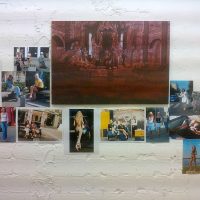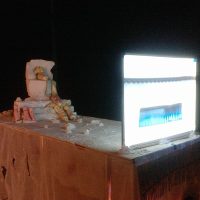John Tiney assimilates into his painting and video an eclectic mixture of images culled from cartoons, film and advertising. The narratives that he creates allow us a glimpse into the underbelly of consumer culture, suggesting that its origins are far more emotive than we may have suspected. The work made for Budapest is a collaboration with David Wilkinson.
Playful and irreverent, Nannette Vinson’s work is also critical of the voyeuristic pleasures of photographic tradition. Working in a variety of media she shifts our gaze ever so slightly to examine the role of cultural memory and persistent assumptions saturating our visual landscape.
János Fodor uses drawing, objects and video images culled from his everyday experience. These intensely observed pieces create new conjunctions and associations that allow us to observe the seemingly inconsequential in a broader context. It is through the associations of the diverse that Fodor allows his work to have a resonance beyond its own materiality.
The work of Rudolf Pacsika shuttles between disciplines and contexts, a rendering of materials and ideas that is nomadic in it resonance. If you find a direct link with place, time and people, you may then find that link broken or dissolved in to another association, and so it goes infinitum. The hermeneutics of space are at the root of his work. What is the local to the foreign? And what systems do we employ to determine our location?
Alexa Hoyer shows us how we might be affected by things that it is impossible for us to really know. Her work whether it is photography, sculpture or a simple text looks to disrupt the surface tension of things. She interferes with or the natural flow and fills the void that is left with the quirky and bizarre, the unsettling.
We create monuments in order to mark time with events, implicating images and therefore locations with notions of the past. The problem is that we are very selective in what we like to remember. It should therefore come as no surprise when Alexander Schikowski reminds us of what we would so desperately like to forget.
What if objects were our only true offspring in this world? What if what we have made consumes us? There are many things that are recognizable in David Wilkinson’s work, sausages, architecture, religion, but what is the unifying whole? Perhaps there is none? In his collaboration with John Tiney we see the grotesque applied with candour, whilst reason sits laughing on the fence.
Bullet Shih’s paintings are compulsive and transgressive, comprised of fragmentary images taken from art history and popular culture. The paint is quickly applied, the images meld, we are left with only a vague impression of what might be depicted. To untangle these painted webs it is better perhaps to consider the intangible, and how painting has always been at the heart of this debate.

